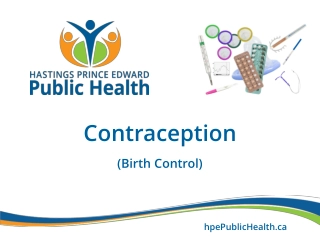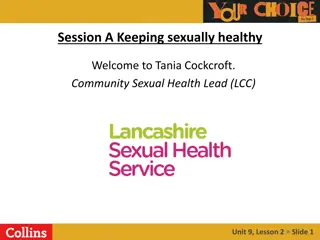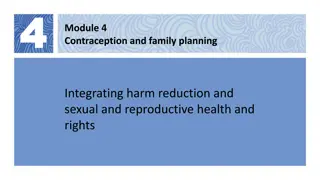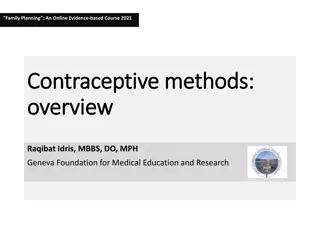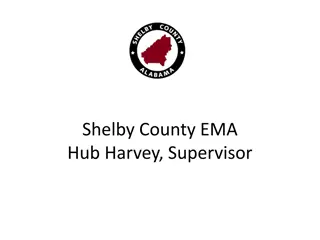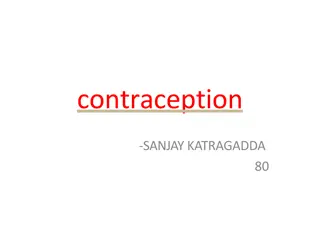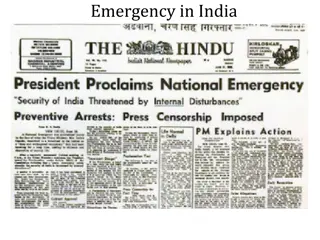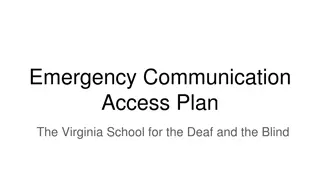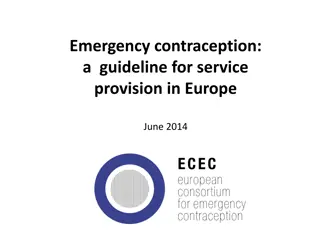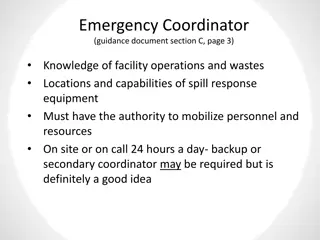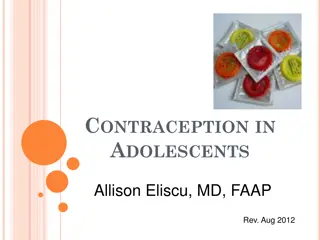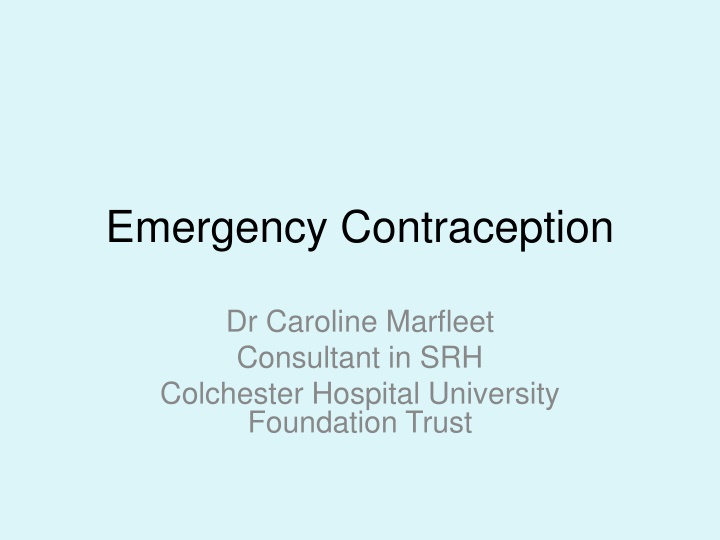
Emergency Contraception - Indications, Risks, and Methods
Learn about emergency contraception, including indications for use, risk of conception, history considerations, different methods available, and the mechanisms of action. Understand when to consider emergency contraception and the options available to prevent unplanned pregnancies effectively.
Download Presentation

Please find below an Image/Link to download the presentation.
The content on the website is provided AS IS for your information and personal use only. It may not be sold, licensed, or shared on other websites without obtaining consent from the author. If you encounter any issues during the download, it is possible that the publisher has removed the file from their server.
You are allowed to download the files provided on this website for personal or commercial use, subject to the condition that they are used lawfully. All files are the property of their respective owners.
The content on the website is provided AS IS for your information and personal use only. It may not be sold, licensed, or shared on other websites without obtaining consent from the author.
E N D
Presentation Transcript
Emergency Contraception Dr Caroline Marfleet Consultant in SRH Colchester Hospital University Foundation Trust
Indications for e.c. UPSI/ split condoms Failure to use additional precautions when starting hormonal methods Failure to use additional precautions when using enzyme inducers or within 28 days of use Missed pills; if 2 or more active pills are missed POP Late or missed pills POI Late injection (> 14 weeks since last Depo or Sayana) IUC removal without immediate replacement; partial or complete expulsion; threads missing and location unknown Rape/ sexual assault/use of teratogenic agents
Risk of conception Conception is most likely to occur on the day of ovulation or in preceding 24 hrs The probability of conception from a single act of intercourse in the 1st3 days of the cycle appears to be negligible
History Reason for requesting e.c Regular partner; casual ; consensual? Need for sexual health check? Timing of all episodes of UPSI in current cycle Most likely date of ovulation based on LMP and usual cycle Use of medications that may affect contraceptive efficacy Any other relevant medial history
Methods of e.c. Hormonal Levonorgestrel e.c. Levonelle (1.5 mg ) Ullipristal acetate e.c. UPA 30 mg (ellaOne) Copper IUDs
Indications LNG e.c. licensed for use within 72 hrs of UPSI UPA licensed for use within 120 hrs of UPSI CuIUD within 5 days of 1stUPSI in a cycle or within 5 days from the earliest date of ovulation
Method of action of LNG e.c. Incompletely understood but primary action is to inhibit ovulation Appears to prevent follicular rupture or cause luteal dysfunction If taken prior to luteal surge, causes ovulatory dysfunction in the next 5 days No better at placebo at suppressing ovulation when given immediately prior to ovulation and not thought to be effective once fertilisation has occurred
Method of action of UPA Progesterone receptor modulator Inhibition or delay of ovulation Suppresses growth of lead follicle Can prevent ovulation after the LH surge has started, delaying follicle rupture until up to 5 days later Ineffective at time of LH peak or after
Method of action of CuIUD Cu is toxic to ova and sperm Primarily inhibits fertilisation If fitted within 5 days of fertilisation, will prevent implantation Effective immediately after insertion
Calculating the last menstrual cycle day when an IUD can be fitted for e.c. Timing of IUD insertion Can be fitted up to 5 days after earliest expected ovulation 26 day cycle Day 17 of cycle 28 day cycle Day 19 of cycle 30 day cycle Day 21 of cycle 32 day cycle Day 23 of cycle
Efficacy of e.c. Cu IUD >99% efficacy LNG e.c. 52-94% efficacy; better if taken soon after UPSI and shown to be effective to 96 hrs ellaOne 98% effective
Side effects with e.c. Cu-IUD Insertion pain Risks of infection in 20 days post insertion Risks of expulsion, perforation, ectopic pregnancy (CEU Guidance IUC Apr 2015) LNG and UPA Headache Nausea <20% Vomiting <1% Altered bleeding patterns
Contraindications Cu-IUD Use of IUD for e.c. has same CIs as routine insertion Risk of STIs, previous ectopic, age, nulliparity are not CIs Hormonal e.c. LNG no medical CIs including breast feeding UPA Hypersensitivity to UPA Severe uncontrolled asthma Caution if hepatic dysfunction; hereditary galactose intolerance; lactose deficiency; glucose- galactose malabsorption
UPA and breast feeding e.c. not indicated until day 21 onwards post partum LAM is >98% effective if < 6 months postpartum, amenorrhoeic and fully breast feeding UPA can be detected in breast milk for up to 5 days after UPA so women should avoid breast feeding for 7 days after UPA
Use of oral e.c. more than once in cycle LNG Can be used more than once in cycle If further UPSI occurs within 12 hrs of LNG, further Rx is not required UPA CEU supports use of UPA more than once in cycle or if there has been another episode of UPSI outside the treatment window (>120 hrs) UKMEC 1 Can give LNG after UPA if another episode occurs, but efficacy may be reduced
Drug interactions Women taking EIDs ( or who have stopped within the last 28 days) should be advised that a CuIUD is the only method of e.c. not affected by these drugs Women taking EIDs including post exposure HIV prophylaxis after UPSI or who have stopped within the last 28 days and who decline or are not eligible for a CuIUD should be advised to take a dose of 3 mg LNG (2 Levonelle)asap within 120 hours of UPSI (outside the product licence). The efficacy after 96 hours is uncertain Women taking EIDs should be advised not to use UPA during or within 28 days of stopping this medication Women should be advised not to use UPA if they are currently taking drugs that increase gastric pH (eg, antacids, proton pump inhibitors, Histamine H2 anatagonists)
Contraception after hormonal e.c. Women may prefer to wait until pregnancy can be excluded before starting a hormonal method of contraception CEU supports quick starting CHC (excluding Co-Cyprindiol), POP or Implant. POI should only be quick started if other methods are unacceptable or not appropriate The LNG-IUS should not be started after hormonal e.c. and a bridging method should be offered
Contraception following LNG e.c. Additional precautions or abstinence should be advised for 7 days when continuing or starting CHC; 2 days for POP or Implant and 9 days for Qlaira
Contraception following UPA e.c. CEU advises that women should not start a hormonal method for 5 days after UPA UPA= day 0 Methods (day UPA + 5) Requirement for additional contraception 7 days UPA then wait at least 5 days CHC (except Qlaira) Qlaira 9 days POP (traditional and DSG) 2 days POI or Implant 7 days
Aftercare Women may be offered follow up if they want a pregnancy test, STI screening, Cu-IUD removal or have any concerns/ difficulties with their contraception Failure of a Cu-IUD should be managed as per Faculty Guidance Failure of hormonal e.c. does not need to be managed differently from other pregnancies If a woman chooses to continue a pregnancy after exposure to UPA, it should be reported to the manufacturer

